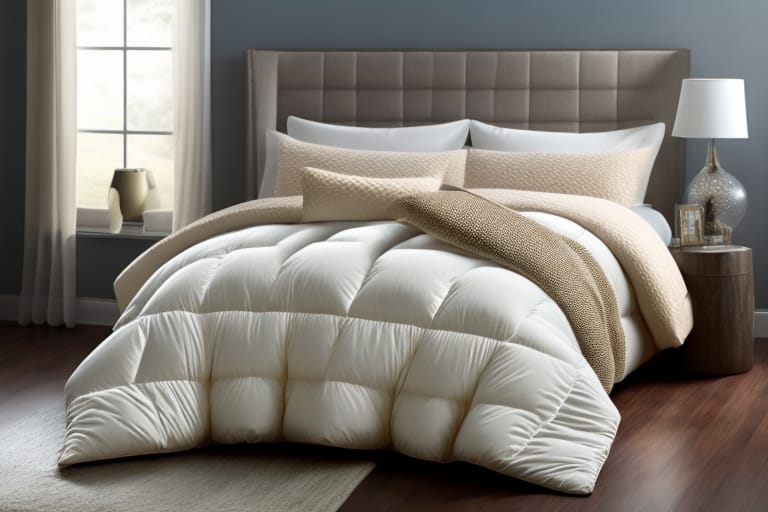Down comforters are a popular bedding choice due to their lightweight warmth and plush feel. However, like any bedding material, down comforters require proper care and maintenance to prevent issues like mold and mildew growth. This beginner’s guide covers everything you need to know to keep your down comforter clean, fresh and mold-free.
An Introduction to Down Bedding
Down comforters are filled with the fine, fluffy clusters and plumules that make up down feathers. This natural fill material is valued for its superior warmth-to-weight ratio.
Some key benefits of down comforters include:
- Lightweight warmth
- Soft, plush feel
- Breathability
- Durability
- Natural moisture wicking
There are a few common types of down comforters:
- White down – Filled with white goose or duck down
- Grey down – Filled with a mix of white and grey duck down
- Alternative down – Filled with synthetic materials
When shopping for a down comforter, key aspects to evaluate include:
- Fill power – Indicates fluffiness and insulation
- Thread count – Impacts breathability and durability
- Construction – Affects even fill distribution
Why Do Down Comforters Get Mold?
While down itself has natural moisture wicking abilities, down comforters can still develop mold or mildew growth under certain conditions.
The main causes include:
- Moisture buildup from sweating or wet hair on the pillow
- Storing in a hot, humid environment
- Not fully drying after washing
- Spills or leaks onto the comforter
Mold spores are present in most environments. When exposed to a warm, moist environment, these spores can rapidly grow into mold colonies.
Areas mold develops in down comforters:
- Inside the comforter shell
- On the surface of down clusters
- Near any moisture retention areas
Health Risks of Moldy Down Bedding
Mold exposure from bedding can negatively impact health in a few key ways:
- Worsening respiratory conditions like asthma
- Triggering allergies and respiratory irritation
- Causing general flu-like symptoms
Some groups at higher risk for effects include:
- Infants and young children
- The elderly
- Those with compromised immune systems
- People with chronic lung disease
It’s important to promptly clean or replace moldy down bedding to avoid prolonged exposure.
Signs Your Down Comforter Has Mold
There are a few key indicators that your down comforter has developed a mold issue:
✔️ Musty odor – The most common sign is a mildew or damp smell
✔️ Discoloration or stains – May see grey, brown or black spots
✔️ Lumping – Mold can cause down clusters to clump together
✔️ Allergy flare-ups – Worsening respiratory issues point to mold
- conduct a visual inspection inside the duvet cover if any above signs are noted*

Cleaning A Moldy Down Comforter
You have a few options if your down comforter develops mold:
Wash at home – Use hot water and bleach-free detergent; extra rinse cycle
Professional cleaning – Takes 1-2 weeks; costs $100+
Replace comforter – Most economical if mold is widespread
No matter which method, proper drying is key – use low heat and commercial size dryers to fully dry down.
Storing Down Bedding to Prevent Mold
Proper storage between uses is vital to inhibit mold growth in down comforters.
Storage Tips
- Store in breathable cotton storage bags
- Avoid plastic bags that trap moisture
- Store in cool, dry place like closet
- Fluff down every 2-3 months
Adding a lightweight duvet cover provides an extra washable barrier against sweat, oils and spills from reaching inner down material.
Washing Down Comforters Without Mold Risk
Care labels provide the best washing guidance for your specific down comforter. But here are some general tips:
- Shake out loose debris before washing
- Use a front-loading machine for large loads
- Wash on delicate cycle in cold water
- Use non-bleach detergent
- Add white vinegar to rinse for freshening
- Dry thoroughly on low heat
Make sure down is completely dry before returning to storage or mold may still develop. Low heat drying preserves maximum loft and warmth.
When To Replace A Moldy Down Comforter
If mold growth cannot be successfully removed or persists after repeated washing, replacement is likely the best option.
Consider replacing if you see:
✔️ Visible mold covering large sections
✔️ Failed DIY mold removal attempts
✔️ Discoloration doesn’t fade after washing
✔️ Musty smell returns quickly
Alternative Bedding Options
For those susceptible to mold allergies, alternative bedding options like down alternative comforters may be preferable.
Benefits:
- Resists mold growth
- Hypoallergenic materials
- Stays fluffy when washed
- Affordable pricing
Downsides
- Less warmth than down per ounce
- Sleeps hotter than down
There are also natural bedding alternatives like organic cotton, wool, and other plant-based materials. The best choice depends on your budget, health factors, and sleeping preferences.

Preventing Mold Growth Long-Term
The key to keeping your down comforter fresh and mold-free for years is consistency following proper maintenance practices:
🔸 Use duvet covers and wash them routinely
🔸 Wash down comforter 2-3 times per year
🔸 Check for mold signs after summer or wet weather
🔸 Fluff in sunlight regularly
🔸 Store in breathable bag in dry area
🔸 Consider periodic professional cleaning
Frequently Asked Questions
What causes mold and mildew to grow in my down comforter?
Mold and mildew growth occur when spores already present in the environment land on a warm, damp spot and are able to multiply. For down bedding, causes usually include moisture buildup from sweating, high humidity storage areas, or failing to fully dry the comforter after washing. Ensuring proper air circulation and dryness prevent mold spores from growing.
How can I tell if my down comforter has mold?
Signs your comforter has developed mold include a persistent musty or mildew smell, grey or brown discoloration, feeling dampness or stiffness in sections, and increased allergy or respiratory issues when using the comforter. Conducting a visual inspection inside the shell can confirm mold growth.
Is it safe to sleep with a down comforter that has some mold?
No, you should not use a down comforter with any mold present. Mold spores can worsen allergies, trigger asthma attacks, cause difficulty breathing and flu-like illness. Infants, the elderly and those with comprised immune function are most vulnerable. Promptly wash or replace comforters with mold.
How often should I clean my down comforter to prevent mold?
To prevent mold growth, wash your down comforter 2-3 times per year in cold water on delicate cycle with a non-bleach detergent. Check for musty odors or stains regularly, especially after summer or wet weather. Add white vinegar or a sanitizing rinse to kill mold spores. Always ensure the comforter is completely dry before use or storage.
Can I prevent mold without frequently washing my down comforter?
Yes, using preventative care between washes can inhibit mold growth. Air out the comforter in sunlight regularly, store in breathable cotton bags rather than plastic, use a duvet cover, and avoid humid storage areas. Fluffing the down every 2-3 months redistributes fill and checks for unseen mold issues. Follow all prevention methods to limit washing.








